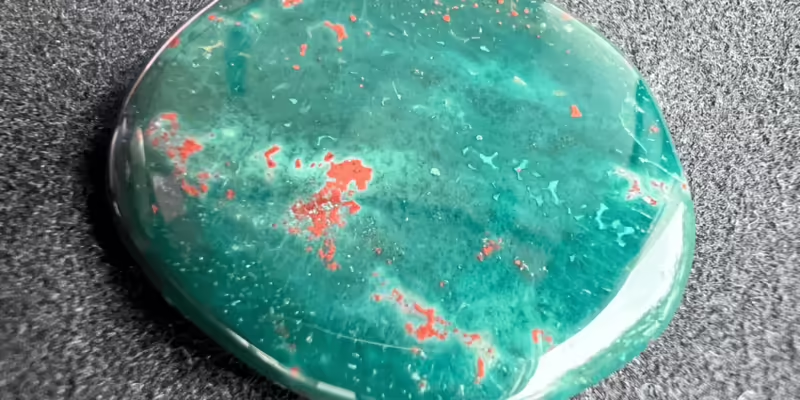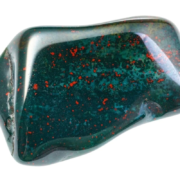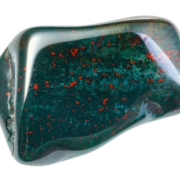Heliotrope: Properties, Uses and Virtues
Heliotrope: The Bloodstone!
Heliotrope, also known as blood jasper or “bloodstone”, is an enchanting gem whose history goes back centuries.
Known for its deep green color and striking flashes of red, Heliotrope is revered for its mystical properties and captivating charm.
Let’s embark on a journey to explore the geological origins, historical significance and metaphysical properties of this exquisite gem.

- Heliotrope Geological Formation
- Rough Heliotrope – Raw Beauty Revealed
- Sources – The Global Scope of Heliotrope
- Historical Significance of the Heliotrope – Through the Ages
- Metaphysical Properties of Heliotrope – Illuminating energies
- Heliotrope Varieties
- Heliotrope Colors
- Durability and Wearability of Heliotrope
- Heliotrope Enhancements – Preserving Natural Beauty
- Synthetic Heliotrope – Nature in the Laboratory
- Imitations of Heliotrope – Discerning the Authentic
- Heliotrope Care – Preserving natural beauty
Heliotrope Geological Formation
Heliotrope forms under metamorphic conditions, usually in rocks such as basalt or jasper, or along riverbeds.
Its creation involves the interaction of minerals, resulting in this unique combination of deep green chalcedony with red to brown iron oxide inclusions.
This process occurs deep in the earth’s crust, giving rise to the amazing gem known as Heliotrope.
Heliotropes may also be called Blood Jasper, but they are more commonly represented as members of the Chalcedony family, in the Quartz family. There is a mineral distinction between blood jasper and heliotrope, due to their different composition.
Rough Heliotrope – Raw Beauty Revealed
As a variety of Chalcedony, and like most polycrystalline materials, Heliotrope has no specific crystalline form.
Its designation as a rock means that it is composed of multiple small crystals. It can be found in the form of large pieces of rock or pebbles along a river.
Sources – The Global Scope of Heliotrope
Heliotrope is found in many parts of the world, including India, Brazil, Australia, China and the United States.
Each source contributes to unique variations in color and pattern, making Heliotrope a diverse and sought-after gem in the world of jewelry.
Historical Significance of the Heliotrope – Through the Ages
Heliotrope has a rich historical significance, dating back to ancient civilizations. Known as “heliotrope”, a name derived from the Greek words “helios” meaning “sun” and “tropos” meaning “to turn”, these gems have been associated with the idea of “turning towards the sun”, probably in order to better appreciate their color variations.
A fascinating aspect of Heliotrope’s historical importance lies in its alleged curative properties, in particular its presumed efficacy against hemorrhaging. George F. Kunz, a notable mineralogist and folklorist, documented the gem’s reputation as a talisman against bleeding ailments, contributing to its enduring appeal in various cultures.
In the Middle Ages, Heliotrope was associated with martyrdom and religious symbolism, used to create carved amulets and religious artifacts. Its deep green color was considered a symbol of growth and renewal, while the red flashes were associated with the blood of Christ.
In addition, Heliotrope became a powerful symbol of bravery, probably due to its associations with blood, vitality and the Roman god of war, Mars. The gem’s deep green color, embellished with vivid red flashes, reflects the essence of life and the courage to face adversity with determination, making it a beloved emblem of valor and inner strength.
Testifying to its revered status, Heliotrope has been designated the traditional birthstone of March, a month named after the god himself.
Metaphysical Properties of Heliotrope – Illuminating energies
In the realm of metaphysical beliefs and historical significance, Heliotrope is considered a stone of purification and healing.
It is believed to promote inner strength, courage and mental clarity, helping the wearer to face difficult situations with calm.
Heliotrope is also associated with grounding and revitalizing energy, making it a prized gemstone for meditation and healing practices.
Heliotrope Varieties
Heliotrope, itself a variety of chalcedony and therefore quartz, has no varieties of its own.
Heliotrope Colors
Heliotrope’s captivating colors encompass a spectrum of greens, from dark forest green to brilliant emerald hues.
The characteristic red to brown flashes add drama and contrast to the gem’s appearance, creating an intriguing visual presentation reminiscent of nature’s wonders.
Durability and Wearability of Heliotrope
Heliotrope offers excellent durability, with hardness ranging from 6.5 to 7 on the Mohs scale.
This level of hardness ensures that Heliotrope is suitable for different types of jewelry and can withstand the rigors of daily use, allowing its beauty to endure over time.
Heliotrope Enhancements – Preserving Natural Beauty
Heliotrope is usually untreated, allowing its natural beauty and metaphysical properties to shine through, but it can be coated with wax or oil to enhance its porous shell, potential fractures and add shine.
This treatment is widely accepted because it fades over time and can be easily reproduced at home.
Synthetic Heliotrope – Nature in the Laboratory
Although natural Heliotropes are prized for their authenticity and unique characteristics, there are no known synthetic or laboratory-grown counterparts for this gem, only imitations.
As a result, Heliotrope remains an exclusively natural gem, guaranteeing its authentic appeal.
Imitations of Heliotrope – Discerning the Authentic
Heliotropes can sometimes be imitated or misrepresented as green glass with red accents, tinted jasper or plastic.
Buyers should exercise caution to ensure that they are buying genuine Heliotrope and not tinted jasper or other imitations.
It is essential to buy from reputable and certified gem dealers to guarantee the authenticity of the gem.
Heliotrope Care – Preserving natural beauty
Care of heliotrope jewelry is essential to preserve its timeless beauty. To preserve its brilliance, avoid exposure to aggressive chemicals and keep it separate from other gems to avoid scratches.
Gently clean Heliotrope jewelry with mild soapy water and a soft brush to preserve its lasting charm.
If coated with wax or oil, treatment can be repeated if necessary.



